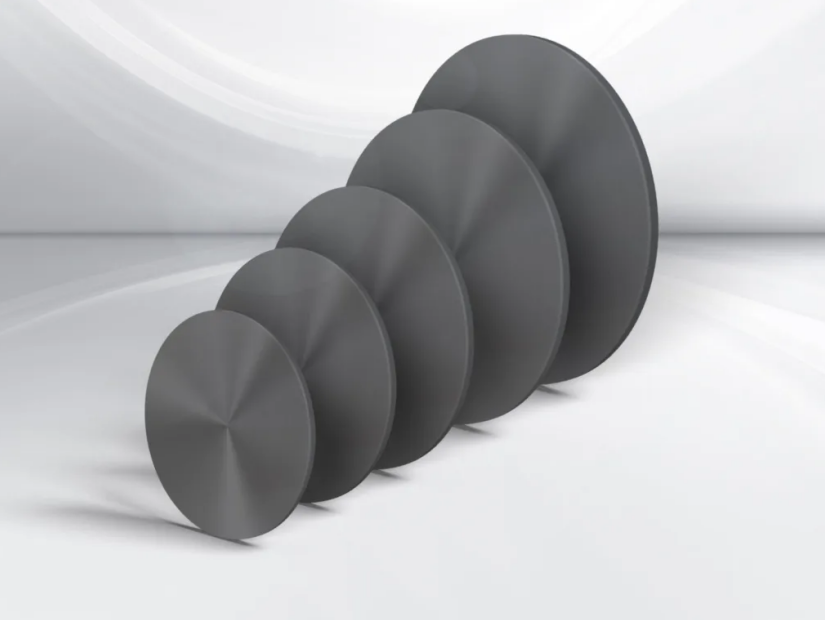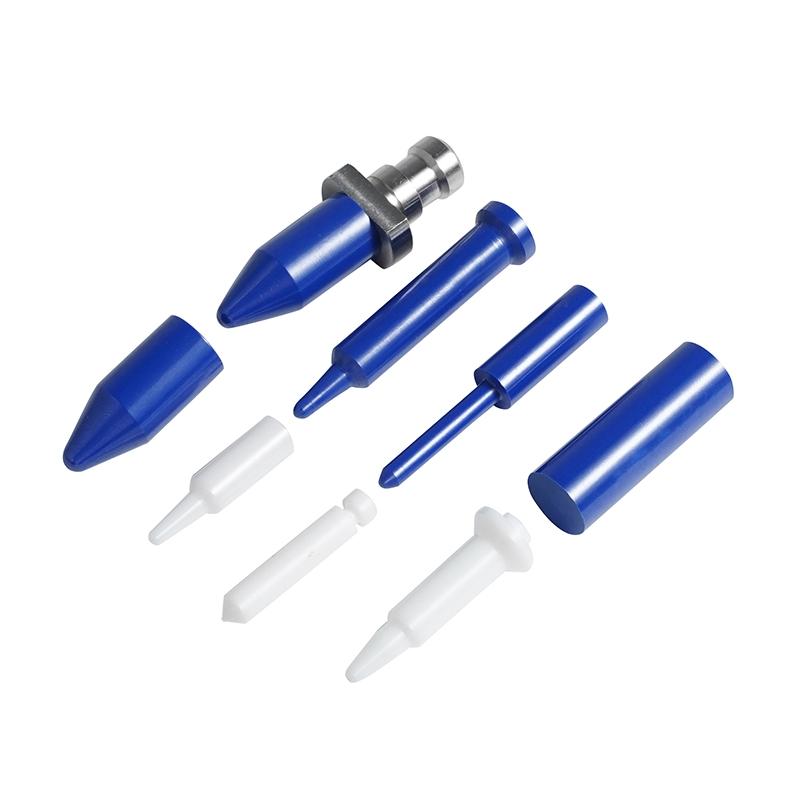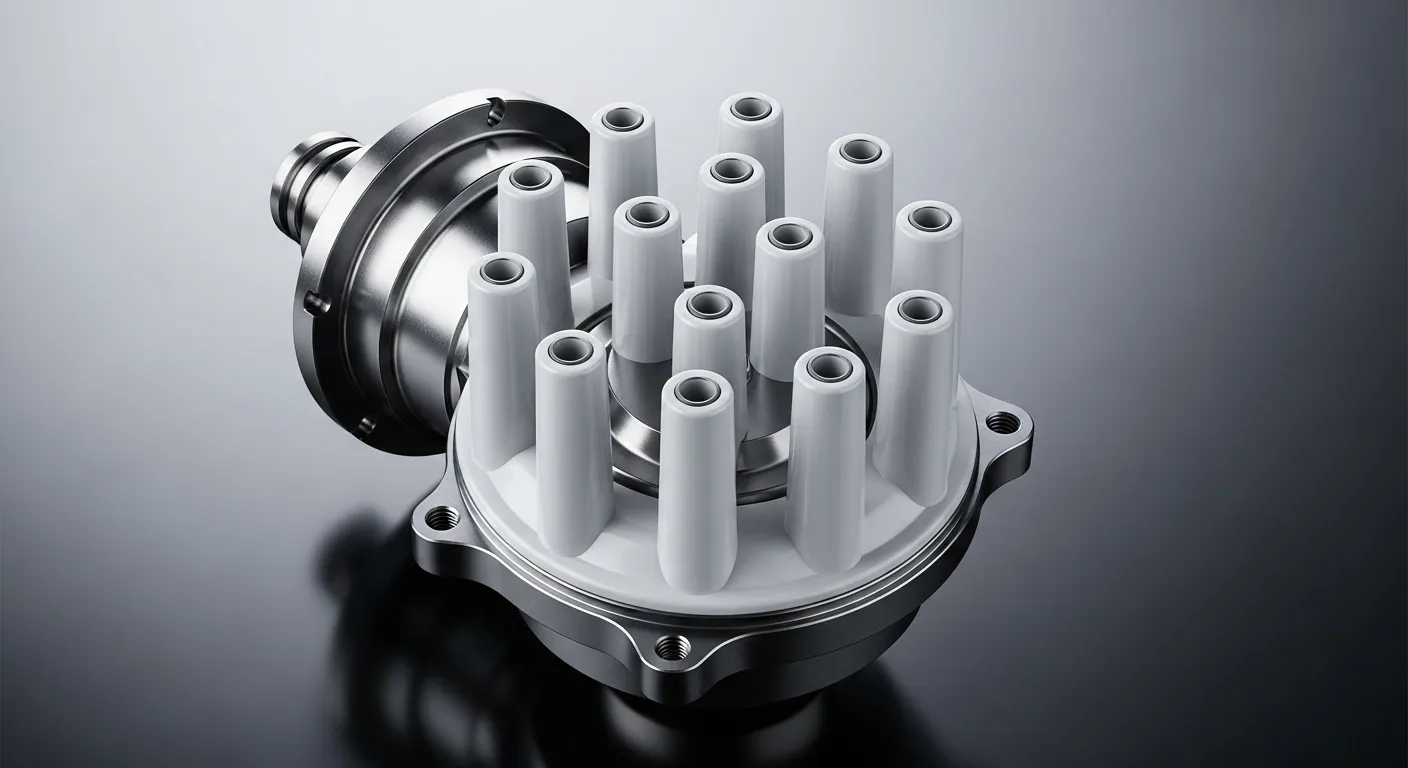High Precision Ceramic Ferrule India: The Ultimate Sourcing Guide
Sourcing a high precision ceramic ferrule in India has become one of the most critical supply chain challenges for the nation's technology sector. This tiny component, often smaller than a grain of rice, is the single most important part for enabling India's 5G, data center, and Fiber-to-the-Home (FTTH) revolutions. Its quality is not a small detail; it is the foundation of network performance.

A single, poorly made ferrule can bring down an entire network link. This guide is for the Indian engineers, procurement managers, and network architects who cannot compromise on quality. We will explore what "high precision" truly means in the context of sub-micron tolerances. We will also detail how to navigate the supplier market in India to find a partner capable of delivering the quality that 5G speeds demand.
What Is a "High Precision" Ceramic Ferrule?
First, we must define our terms. A "ceramic ferrule" is a precision-engineered tube that holds and aligns a single optical fiber within a connector. The term "high precision" specifically refers to ferrules designed for single-mode fiber applications.
What makes a ceramic ferrule "high precision"?
A high-precision ceramic ferrule is defined by its sub-micron manufacturing tolerances. Its purpose is to align single-mode fiber cores, which are only $8$ to $9$ microns ($\mu\text{m}$) wide. This requires the ferrule's inner hole to be centered with its outer diameter with an error (concentricity) of less than one micron.
This distinction is the most important one to make.
- Multimode Ferrules: These are used for multimode fiber, which has a large core ($50\mu\text{m}$ or $62.5\mu\text{m}$). Aligning these large cores is simple, so the precision requirements are much lower.
- High Precision (Single-Mode) Ferrules: These must align an $8\mu\text{m}$ core. For scale, a human hair is $70\mu\text{m}$ thick. A 1-micron misalignment is a catastrophic failure. These are the components that run the backbone of the internet.
The "Why India?" Context: A Market in Hyper-Drive
The search for a high precision ceramic ferrule India supplier is not a normal market trend. It is a surge in demand driven by a complete technological transformation of the country.
Why is demand for high-precision ferrules in India so high?
The demand for high-precision ferrules in India is exploding due to the massive, simultaneous rollout of 5G, the expansion of Fiber-to-the-Home (FTTH) networks, and the construction of hyperscale data centers. The "Make in India" initiative is also pushing companies to find high-quality domestic suppliers for these critical components.
1. The National 5G Rollout
India's 5G deployment is one of the fastest in the world. Each of the hundreds of thousands of new 5G towers requires a high-bandwidth fiber optic "backhaul" link. These links must be low-loss and high-reliability. This creates an enormous, immediate demand for millions of high-performance connectors, each built around a high-precision ferrule.
2. The FTTH and "Digital India" Boom
Broadband providers like Jio and Airtel are in a race to connect tens of millions of Indian homes with high-speed fiber. This FTTH revolution requires a massive volume of connectors, patch cords, and splitters. The ferrule is the base component for all of it. A high-quality ferrule ensures a stable connection for the end-user.
3. The Data Center Hub
India is rapidly becoming a global hub for hyperscale data centers, especially in cities like Mumbai, Chennai, and Hyderabad. These facilities run 400G and 800G networks. These high-speed links are extremely sensitive to signal loss and reflection. They can only use "premium" or "ultra-premium" grade ferrules to function.
4. The "Make in India" Initiative
The Indian government has strongly encouraged a shift from simply importing technology to manufacturing it. This has pushed local assemblers and new entrepreneurs to develop domestic manufacturing capabilities. They are working to build a secure supply chain for critical components, and the ferrule is at the top of the list.
The Material of Choice: Why Zirconia is Non-Negotiable
You cannot build a high-precision ferrule from just any material. Early attempts with metal and plastic failed.
- Metal (like stainless steel) expands and contracts too much with temperature changes, causing the fiber to go out of alignment.
- Plastic is too soft. It deforms over time ("creep") and cannot be polished to the required precision.
The entire global industry has standardized on one material: Zirconium Oxide (ZrO2), or Zirconia.
What material are high-precision ferrules made of?
High-precision ceramic ferrules are made from a specific grade of Zirconia called Yttria-Stabilized Zirconia (Y-TZP). This material is often called "ceramic steel" because it is incredibly strong and tough. Its main advantage is a thermal expansion rate that is almost identical to the glass fiber it holds.
This material is chosen for three key reasons:
- Thermal Stability: This is the most important property. Zirconia and glass fiber expand and contract at nearly the same rate. This means that as the connector heats up in a data center or cools in an outdoor cabinet, the alignment between the two fiber cores remains perfect.
- Extreme Hardness & Durability: Zirconia is incredibly hard. It resists scratches and wear during repeated connections (matings).
- Fine Grain Structure: Zirconia's nano-scale grain structure allows it to be polished to a mirror-smooth finish. This is essential for creating the perfect end-face geometry for a low-loss connection.
The Language of Precision: Key Ferrule Specifications
When you source a high precision ceramic ferrule India supplier, you are not just buying a part. You are buying a set of guaranteed tolerances. You must be able to read the spec sheet and know what matters.
1. Outer Diameter (OD)
This is the main body diameter. It must fit perfectly into the connector housing and the adapter's alignment sleeve.
- $\varnothing 2.5\text{ mm}$: The "standard" size for SC, ST, and FC connectors. Common in telecom.
- $\varnothing 1.25\text{ mm}$: The "small form factor" size for LC and MU connectors. This is the dominant standard for high-density data centers and 5G equipment.
The tolerance on the OD is often $\pm 0.0005\text{ mm}$ ($\pm 0.5\mu\text{m}$).
2. Inner Diameter (ID) / Bore
This is the tiny capillary hole that holds the glass fiber. The fiber itself (the cladding) is $\varnothing 125\mu\text{m}$.
- Standard ID: $\varnothing 125.5\mu\text{m}$ or $\varnothing 126\mu\text{m}$.
- Tolerance: Often $+1\mu\text{m} / -0\mu\text{m}$.
- This is a critical tolerance. The hole must be slightly larger than the fiber to allow for epoxy. But if it is too large (e.g., $127\mu\text{m}$), the fiber will be off-center inside the hole, creating a new alignment problem.
3. Concentricity (The Most Important Metric)
This is the specification that defines "high precision."
What is ceramic ferrule concentricity?
Concentricity is the measurement of how far the center of the tiny inner hole is from the true center of the 2.5mm or 1.25mm outer diameter. It is the most critical metric for performance. Poor concentricity is the number one cause of high signal loss (Insertion Loss).
A premium supplier in India will sell ferrules in different "grades" based on this single number.
- Standard Grade (Grade B): Concentricity is typically $\leq 1.0\mu\text{m}$. This is the baseline for single-mode applications.
- Premium Grade (Grade A): Concentricity is $\leq 0.7\mu\text{m}$.
- Ultra-Premium Grade (Grade A+): Concentricity is $\leq 0.5\mu\text{m}$, or even lower. These are required for 400G+ data center links where every fraction of a decibel of loss counts.
When you pay more for a "high precision" ferrule, you are paying for this guaranteed low concentricity.
The Impact of Precision: IL, RL, and End-Face Geometry
Why do these sub-micron numbers matter? They directly impact the two key performance metrics of a network link: Insertion Loss and Return Loss.
Insertion Loss (IL)
Insertion Loss is the amount of light (signal) that is lost at a connection point. It is measured in decibels (dB). A high IL (e.g., $1.0\text{ dB}$) is terrible. A low IL (e.g., $0.1\text{ dB}$) is excellent.
The primary cause of high IL is lateral misalignment of the fiber cores. This is exactly what high concentricity prevents. A low-concentricity ferrule ensures the cores line up, minimizing the amount of light that "misses" the other fiber.
Return Loss (RL)
Return Loss is the amount of light that is reflected back toward the laser source. A high RL value (e.g., $60\text{ dB}$) is excellent, as it means very little light is being reflected.
Reflections are poison for a network. They can corrupt the data signal and even destroy the laser. While concentricity plays a role, RL is mostly controlled by the polish on the ferrule's end-face.
End-Face Polish: PC vs. UPC vs. APC
A high-precision ferrule is ground and polished to a specific 3D shape, or "end-face geometry."
What is the difference between UPC and APC ferrules?
A UPC (Ultra Physical Contact) ferrule is polished flat at a 0-degree angle. It offers very good performance (RL $\approx -55\text{ dB}$) and uses a blue connector. An APC (Angled Physical Contact) ferrule is polished at a precise 8-degree angle. This angle reflects light away, providing excellent performance (RL $\geq -60\text{ dB}$). It uses a green connector.
- UPC (Ultra Physical Contact): Polished at $0^\circ$. This is the "standard" for most digital data links. Connectors are blue.
- APC (Angled Physical Contact): Polished at $8^\circ$. This angle is a clever trick. Any reflected light bounces off at an angle and is lost in the fiber's cladding. It cannot travel back to the source. This is the standard for video, FTTH, and analog signals. Connectors are green.
Crucial Rule: You can NEVER mate a green APC connector with a blue UPC connector. The flat and angled surfaces will collide, permanently damaging both fibers and guaranteeing a signal failure.
The "Make in India" Reality: Understanding the Supplier Landscape
When you search for a high precision ceramic ferrule India supplier, you will find three types of companies. It is vital to know who you are dealing with.
Type 1: The Full-Scale Domestic Manufacturer
This is a true "Make in India" company. They perform the entire manufacturing process on Indian soil. They import the raw Zirconia powder, run their own injection molding, manage their own sintering furnaces, and operate their own diamond grinding lines.
- Pros: Complete control over the process, strong engineering depth, secure domestic supply chain, R&D capabilities.
- Cons: This is the most capital-intensive model. The number of such companies is small but growing.
Type 2: The Domestic Processor / Grinder
This is a very common and successful model in India. These companies import "ferrule blanks"—the un-ground, sintered parts—from major blank manufacturers in China or Japan. They then perform the most critical, high-value step in India: the precision diamond grinding, polishing, and quality control.
- Pros: Deep expertise in the most difficult part (precision grinding). They are machining experts.
- Cons: Still reliant on an international supply chain for their blanks.
Type 3: The Distributor / Trader
This is the most established part of the market. These are large, authorized importers and stocking distributors for the world's biggest ferrule brands (from China, Japan, or the USA). They buy in massive volumes and manage the logistics.
- Pros: Excellent relationships with global brands, large local inventory, and fast delivery.
- Cons: They are resellers. They have no control over manufacturing and cannot offer customization. Their quality is simply the quality of the brand they represent.
How to Vet a High Precision Ceramic Ferrule India Supplier
Your goal is to find a long-term partner, not just a seller. Use this checklist to ask the right questions and qualify a potential supplier.
Step 1: Ask About Their Process
Your first question must be: "Who are you?"
- "Do you perform your own grinding and sintering in India?"
- "Do you import finished ferrules or semi-finished blanks?"
- "Can we tour your manufacturing and QC lab?"A manufacturer will be excited to show you their grinding machines. A trader will want to show you their warehouse.
Step 2: Demand Quality Data
This is non-negotiable. A professional supplier lives by its data.
- "Can you provide a Certificate of Conformance (CoC) with every batch?"
- This document is your proof that the batch meets the specs you ordered (e.g., "Concentricity $\leq 0.7\mu\text{m}$").
- "Can you provide sample interferometry reports for your end-face polish?"
- This is a 3D scan of the polished tip. It proves they can control the radius of curvature and apex offset.
If a supplier says "we just check it with a microscope," walk away.
Step 3: Ask About the Raw Material
Show them you understand the technology.
- "What is the source of your Zirconia powder or blanks?"A high-quality supplier will know their source. They will proudly state they use powder from leading Japanese suppliers (like Tosoh or Kyoritsu) or blanks from top-tier Chinese factories. A low-quality supplier will not know or will be vague.
Step 4: Check for Global Compliance
This is a simple check for professionalism.
- "Are your components RoHS and REACH compliant?"This ensures the parts are free of hazardous materials. It is a legal requirement for exporting to Europe and a global benchmark for a quality-managed company.
Step 5: Start with a Sample Order. Trust, but Verify.
Never place a 10-million-piece order based on a data sheet.
- Request a sample batch (e.g., 500-1000 pieces).
- Give them to your production team. Have them build connectors.
- Give them to your QC lab. Test the finished patch cords for Insertion Loss (IL) and Return Loss (RL).
The data from your own tests is the only truth.
The Manufacturing Process: How Precision is Built
To appreciate the quality, you must appreciate the process. This is a journey from simple powder to a sub-micron component.
- Powder & Molding: It starts with nano-grade Zirconia powder. This is mixed with a binder and injection-molded into a "green part." This part is larger than the final ferrule and is still soft.
- Sintering: The green parts are placed in a high-temperature furnace. The binder is slowly burned out, and the part is then heated to over 1400°C. The Zirconia particles fuse and the part shrinks, becoming incredibly hard. This is a core process of ceramic engineering.
- Grinding: The hard, sintered part is now machined. This is the "precision" step. Since Zirconia is so hard, it can only be cut with diamond. The outer diameter is "centerless ground" and the inner bore is drilled and lapped to its final, exact dimension.
This multi-stage, high-capital process is why true ferrule manufacturing is so difficult and why so few companies in the world have mastered it.
The Global Context: How India's Market Fits
No market is an island. A smart procurement strategy in India involves understanding the global supply chain.
- China: The world's largest manufacturer of high-precision ferrules. They dominate high-volume production with excellent quality and scale.
- Japan: The world's largest innovator and supplier of the raw Zirconia powder.
- Ceramic Ferrules USA: The US market focuses on specialty ferrules for military, aerospace, and advanced medical R&D.
- Ceramic Ferrules Europe: Known for precision engineering for custom industrial automation and sensor applications.
- Ceramic Ferrules Indonesia: A market very similar to India's, experiencing a massive boom in FTTH and data center construction.
Conclusion: Your Network Is Only as Strong as Its Smallest Part
The demand for a high precision ceramic ferrule India supplier is a sign of a maturing and advanced technology market. The "Make in India" initiative is not just about assembling phones; it is about mastering the deep, complex manufacturing of critical components like this.
As an engineer or supplier, your success depends on this component. Your network is only as fast, stable, and reliable as the sub-micron alignment inside every connector. By demanding proof of quality, understanding the specifications that matter, and vetting your partners, you can build a supply chain that is strong enough for India's digital future.
To learn more about the fundamental science and the full range of ferrule types, please see our complete guide to ceramic ferrules.
In This Article
- 1 What Is a "High Precision" Ceramic Ferrule?
- 2 The "Why India?" Context: A Market in Hyper-Drive
- 3 The Material of Choice: Why Zirconia is Non-Negotiable
- 4 The Language of Precision: Key Ferrule Specifications
- 5 The Impact of Precision: IL, RL, and End-Face Geometry
- 6 The "Make in India" Reality: Understanding the Supplier Landscape
- 7 How to Vet a High Precision Ceramic Ferrule India Supplier
- 8 The Manufacturing Process: How Precision is Built
- 9 The Global Context: How India's Market Fits
- 10 Conclusion: Your Network Is Only as Strong as Its Smallest Part
 English
English 中文
中文





